Modern Healthcare Technology Blog
.jpg)
340B Webinar Series - 340B Compliance & Savings: Part 1
In Part 1 of the 340B Webinar Series - 5 Reports to Ensure 340B Compliance and Maximize Savings Larry Crowder, VP of Cervey and Ambre Ayoub, 340B pharmacy compliance analyst with Seattle Children's Hospital are going to cover the first of five 340B reports, the NDC or Code Mismatch Report. These five reports are to ensure compliance, maximize savings in the 340B program.
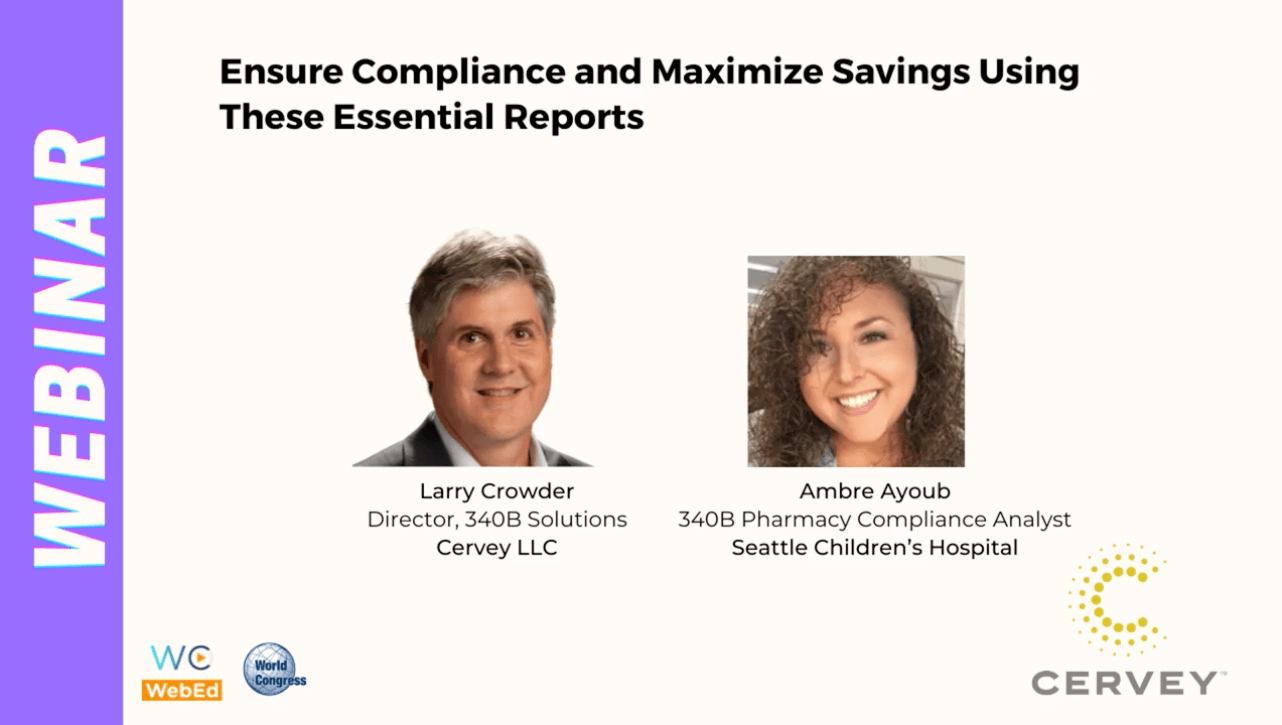
340B Webinar Series - 5 Reports to Ensure 340B Compliance and Maximize Savings: Part 1
Sean:
We are going to move to our next session, which is sponsored by Cervey, Ensure Compliance and Maximize Savings Using These Essential Reports. We are pleased to have with us today Larry Crowder, who's the VP of 340B solutions at Cervey, and Ambre Ayoub is a 340B pharmacy compliance analyst with Seattle Children's Hospital. Welcome to both of you. Thanks for being here. Larry, without further ado, we're going to turn it over to you.
Larry Crowder:
Thanks, everyone for being here this afternoon. We hope if you're on the phone, you enjoy hearing about 340B reports and all their updates. But we hope you don't get off the seminar yet or the webinar yet because we’re excited about what we're going to be showing you today.
We're going to be showing you some real practical reports. If you're managing a 340B program, that you can be running to help make yourself efficient in finding any kind of issues or problems with your 340B program. We’re excited because we have Ambre Ayoub on the phone today, and she's with Seattle Children's. To give you a background on each of us, I've actually been working in the 340B world for about 17 years.
History of Cervey
Larry Crowder:
Our history comes from the fourth largest wholesaler in the US, Morris & Dickson. We were the technology arm for Morris & Dickson, and in October 2019, we became Cervey. That gives us kind of a unique perspective on pharmacy and hospital operations. And so we bring that uniqueness to the table, but there's nothing like being a covered entity who's actually in there every day and dealing with 340B.
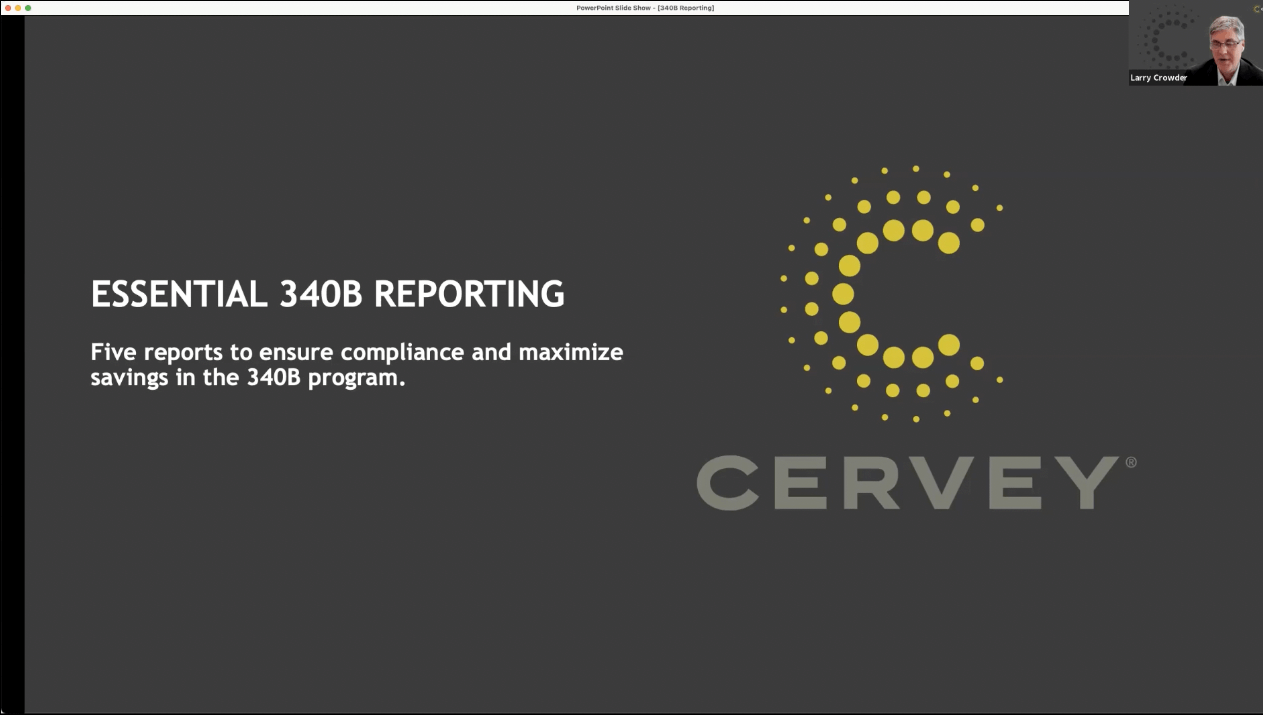
Essential 340B Reporting
Larry Crowder:
And that's what Ambre is bringing to the table and she's going to bring her insight into some of the reports that they run at Seattle Children's and what her thinking is as far as doing daily, weekly, monthly reports. These reports are going to help you, be very efficient in finding any issues that you might have in the 340B program and fixing those quickly, maximizing your savings, and ensuring compliance.
So without further ado, we'll get started. We're going to start off with the overview and the purpose to give you a breakdown of the agenda. We're going to go through these five reports that were mentioned that are the most helpful or benefit you the most in being efficient with your program. And then we're going to go over some other reports that you might be able to run as well. And then Ambre is actually going to show a sample report schedule of what Seattle Children's does.
We will get going here. Again, the overview and the purpose of this is to show you some reports that you can use, basically data analytics, to help find those issues. If you're dealing with every now and then you find a big issue in your program, and then it takes a lot of time to help clean the data up, get the issue fixed, is it a material breach, how far back do we have to go. If you're finding those issues and it always seems like you're lagging a little bit behind when you find something, then this is for you.
This is going to show you how to find those issues before they fester or before they become big to your program before they become a material breach that you would have to report to HRSA.
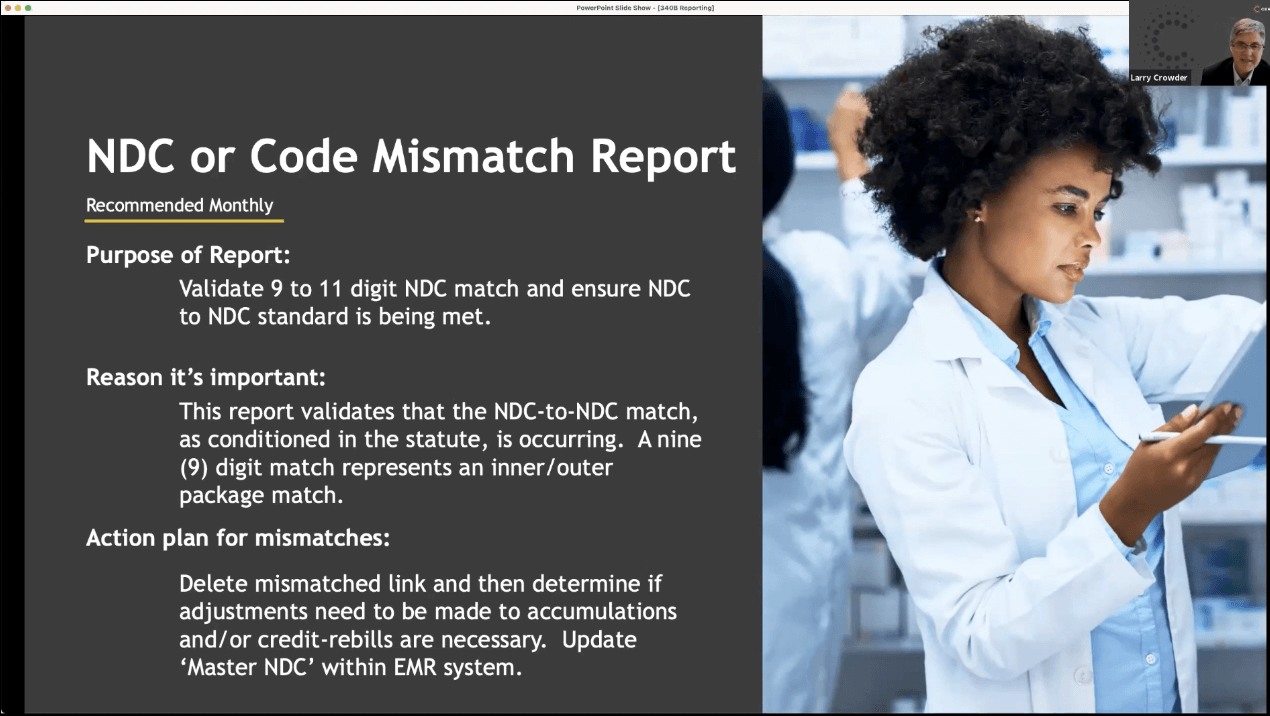 NDC or Code Mismatch Report
NDC or Code Mismatch Report
Larry Crowder:
The first report that we're going to talk about is this NDC or Code Mismatch Report. This is speaking to those entities. If you're scanning the patients at the bedside and you actually have the NDCs coming across the file, the usage file, or the dispense file for your software, then you know that from time to time there are some areas of the hospital or even some moments where the actual NDC is not scanned.
You might have the software or your EMR system grab the Master NDC and the Master NDC comes across. What happens to that Master NDC when it comes across? That's something that has been vetted. Is it found? Is it accumulating the wrong Master NDC? Is that your actual NDC that you're using right now? That's what this report can help you find. If you're using a different NDC, so you're purchasing one NDC, but you have a Master NDC coming from your EMR system that is not the one you're purchasing, this report can help you find those.
It validates that NDC to NDC match. And you're going to see in here if you have a nine-digit match, that's typically the inner/outer NDC, but it may not be, so that's something else to consider for the report. But then it's going to help you find those issues quickly so that you can identify the items before anything happens again in a long time frame. Before Ambre comes in, to show you each one of these, we’re going to show you how to run the NDC or Code Mismatch Report.
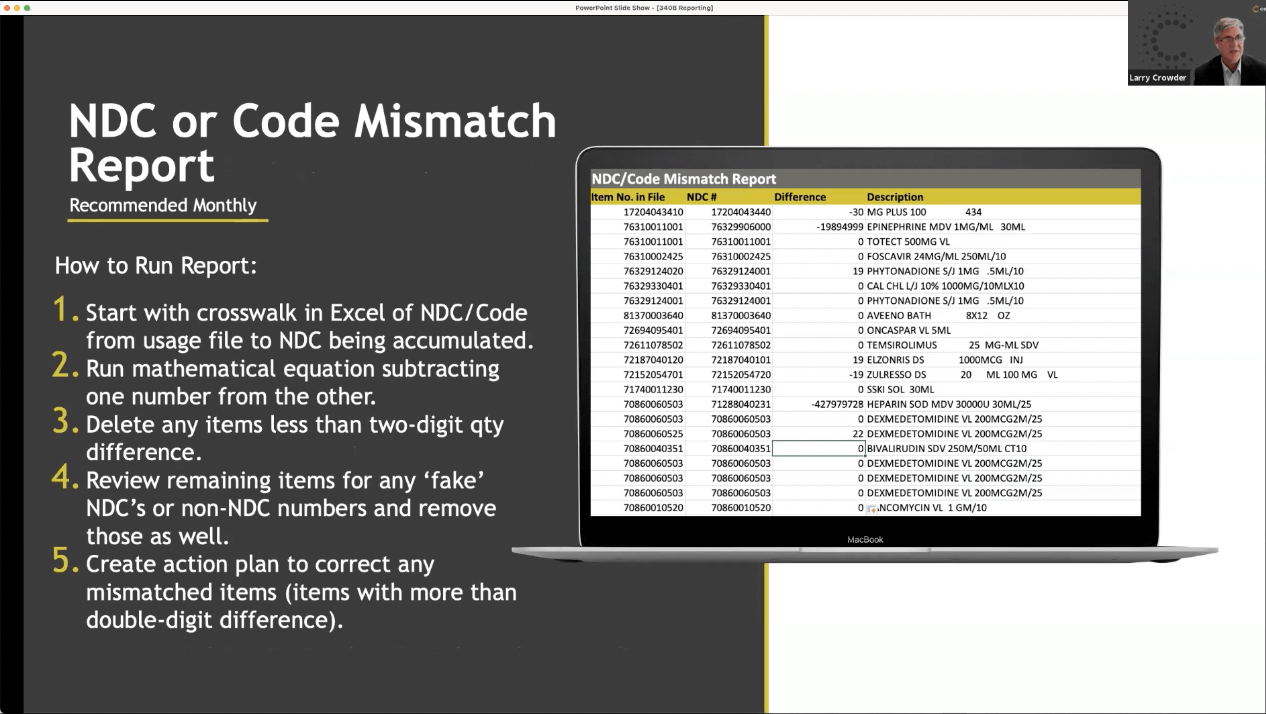 How to Run the NDC or Code Mismatch Report
How to Run the NDC or Code Mismatch Report
Larry Crowder:
So even if your TPA doesn't have this report in their software, you can run this report manually. If you can get a crosswalk from your TPA showing you the NDCs that are coming across the file and what they're attached to, or any number coming across the file and what it's attached to, then you can run this report simply by putting those in a spreadsheet side by side and doing a simple differential equation.
And so if anything is more of a difference than a two-digit number, so if it's not zero or two digits, if it's a big number, as you can see on the screen right here. Then that might be an item where you have dissimilar NDCs connected to each other. There are some different things that could happen here. Maybe you're not sending an NDC, but now we are going open it up to Ambre. And Ambre, tell us how often do you run this report and what kinds of things would you note here as far as the NDC Mismatch Report?
How Often to Run the NDC or Code Mismatch Report
Larry Crowder:
We recommend that this report is run monthly to validate the 9 to 11 digit NDC match and ensure NDC to NDC standard is being met.
Ambre Ayoub:
So we usually do the NDC Mismatch Report on a quarterly basis when we review our master crosswalk for our NDC. We make sure that what you had mentioned earlier about inner and outer NDC, obviously we know that it's imperative to ensure that we're linking correctly. So if you link an inner NDC that might be a five mL vial, but the Master NDC that it links to in the system is a 20 mL vial, your accumulations are going to be off. You got to be sure to pay attention to that.
So when we run this report and if we find something, we usually make our master crosswalk. We put the information in the notes section saying, "Hey, the dash zero five is a five mL vial in the dash 10 carton of number 10." So that if we have an audit, we can actually show, we can show HRSA, "Hey, this is accurate because it's the same mL vial. And it's actually the inner-outer corresponding NDC." So yeah, we do this on a quarterly basis.
Finding Discrepancies in Your NDC or Code Mismatch Report
Larry Crowder:
And so there are a couple of things there that Ambre mentioned. And we think one of the things about this report is you could have some fake numbers in there. So you could have, we know a lot of Epic users are on the call. You could have a 90, 99 in DC that you created that represents a compound or some other packaging that you're doing internally on an NDC. So those would be acceptable as long as it's that NDC that it should be connected to, but you can also actually scan UPC codes. So we've seen some accounts where they'll scan a UPC code that represents a certain NDC. And so those numbers might have a big difference here on this report, but it's actually still the same item. It's the same NDC that it represents. So it's important to know those things.
But the nice thing about this report is it narrows it down to those items that there is a difference in the numbers, and then you can take it from there and make a decision on whether or not it's acceptable. It's a UPC code and that's okay. Or it's something else that needs to be looked at. So if you do find anything there, then you obviously want to create a plan to help correct it. And so the first thing that you would want to do is delete that link.
Obviously, you're going to want to delete the link and then you're going to want to go through, and you're going to make sure that you haven't erroneously been accumulating the wrong NDC and that adjustment on your accumulations. And then obviously if there's a material breach there, then you take other steps with that.
Conclusion
Follow us to stay tuned for Part 2 of the 340B Webinar Series - 5 Reports to Ensure 340B Compliance and Maximize Savings here:
Contact Cervey for a demo of our 340B suite of web-based products that help 340B-eligible healthcare providers with three of their most pressing 340B needs: maximizing savings, ensuring compliance, and optimizing the performance of their contract pharmacies.
Looking for the rest of the webinar series? Check out parts 2-7 below:
- 340B Webinar Series - 5 Reports to Ensure 340B Compliance and Maximize Savings: Part 2
- 340B Webinar Series - 5 Reports to Ensure 340B Compliance and Maximize Savings: Part 3
- 340B Webinar Series - 5 Reports to Ensure 340B Compliance and Maximize Savings: Part 4
- 340B Webinar Series - 5 Reports to Ensure 340B Compliance and Maximize Savings: Part 5
- 340B Webinar Series - 5 Reports to Ensure 340B Compliance and Maximize Savings: Part 6
- 340B Webinar Series - 5 Reports to Ensure 340B Compliance and Maximize Savings: Part 7
Last Updated: 5/17/2022
